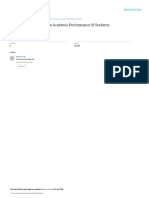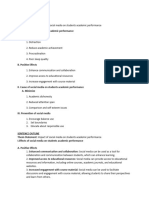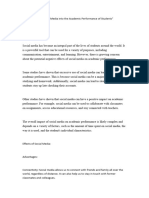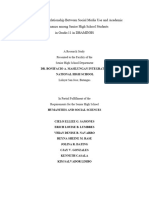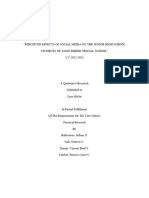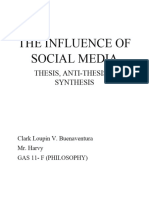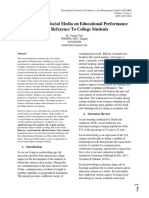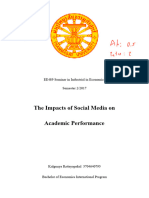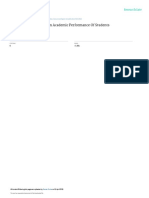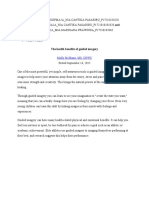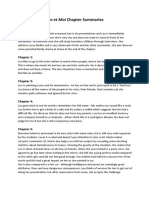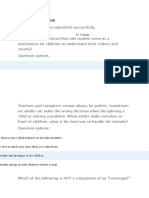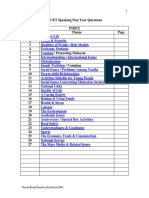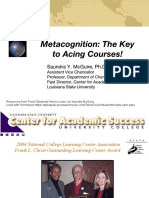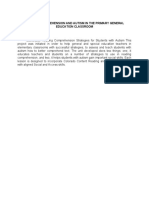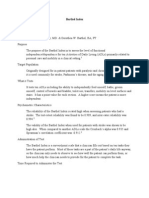FOREIGN
Karani, &Sumana (2015) and Osharive (2015) reported that those who are addicted to social
networking sites tend to have poor academic performance. It is being stated here that too much
used of social media and social networking can lead to distraction in others priority. It affects our
cognitive functions and lead to poor performance in school. Raymond et al., 2016). It represents
a dynamic medium where information dissemination is coupled with interactive engagement,
distinguishing it from traditional media channels. It is being stated that social media plays an
important role in individuals needs and contribute someone’s lives as it is our medium of
information to disseminate information to someone. It helps us to become more interactive and
encourage students’ engagement. Caratiquit (2023) stated that social media addiction
significantly influences academic procrastination. This means that when learners spend too much
time on social media are likely to have academic procrastination. It shows that too much time on
social media can lead to procrastination, which in turn negatively affects students’ academic
success. Accordingly, the current study is supposed to be useful, since it is a new in Afghanistan,
among undergraduates in Alberoni University. Because in an academic environment, beside
traditional resources, students also need a new informational technology such as social media. As
said by Sudha and Kavitha (2016) social network sites have attracted considerable attention
among scholars and educators due to the increasing popularity among students and the potential
effect on academic performance. Social media has become a vital role of academic performance
settings, providing students with fresh opportunities for learning, collaboration, and sharing
information. The use of social networking platforms marks a transformation in educational
practices, serving as a supplement to conventional learning tools. Social media is now a big part
of education. Students at Alberoni University in Afghanistan can use it to find information, share
ideas, and connect with others. It is useful because it adds to books and other traditional learning
tools. Hasnain, Nasreen and Ijaz (2015) stated that the development of technology and increase
in internet usage, social media has become a part of our daily lives. If social media is used in a
positive way, it can help students and youth to get knowledge that can be used to improve their
academic performances. Social media has both positive and negative effects on the academic
performance of college students. On the positive side, it provides access to educational resources
and facilitates connections with peers and professionals. However, it can also lead to distractions,
causing procrastination and reduced focus on studies. Additionally, mental health issues like
anxiety and depression, often exacerbated by social media use, can hinder academic success.
(Raut and Patil, 2016). The use of social media is being rapidly rising during last few years. It is
not only being used by the working people but also there is heavy increase in the use of social
media by the students or education society. Social media also provides diverse learning
opportunities, with platforms like YouTube and TikTok offering alternative formats that cater to
different learning styles. To maximize the benefits, educators can incorporate social media into
the curriculum for assignments and discussions. It is also essential to promote digital well-being
by encouraging students to manage their time on these platforms effectively and to provide
guidance on responsible use, including online etiquette and awareness of their digital footprints.
Menseh and Nizam (2016) described that social networking have a meaningful effect on the
�students' academic performances. They also pointed out about the abnormal use of social media
platforms by students. The study suggested it is useful that universities and colleges in Malaysia
educate their students to use these platforms positively for educational purposes which will
ultimately result in a positive impact on their academic performance. Social media can help
students learn by sharing ideas and resources. However, if students use it too much, it can
distract them and lower their grades. Malaysian universities should teach students how to use
social media in a positive way. This can improve their learning and keep them focused. Programs
and workshops can help students use social media wisely. Jha, and Sinha (2016) asserted that
students more probably affected by social media. To some extent, it absolutely affects the lives of
college students counting the grades. They added that social media is attractive as it gives college
students another world to make friends, also provides a good way to release pressure. It was also
noted that an approach is required to balance the relationship between social media and academic
study. Consequently, college students should think more about the balancing of social media and
academics. There are many studies performed about the positive and negative effects of social
media on the students' academic performances. For example, Heffner (2016) alleged that the use
of social media can be a good outlet to deal with academic frustrations, especially if the students
are in contact with another student that is having the same problem. Mingle and Adams (2015)
asserted that majority of respondents experienced negative effects i.e. poor grammar and
spelling, late submission of assignment, less study time and poor academic performance because
of too much use of social media networks. Moreover, addiction toward using social media
among students was high. Study by Alhabash et al. (2015): This research found that social media
platforms foster collaborative learning environments, where students share knowledge and
resources, enhancing their academic experiences. Highlights how social media helps to develop
cooperative learning settings. Sharing of ideas, resources, and criticism by students improves
their group grasp of course material. This interaction promotes peer-to--peer learning, therefore
developing a sense of community among pupils. Such cooperation will eventually result in a
more enriching educational experience as well as better academic achievement. Social media
when used in academics has both advantages and disadvantages. Social media helps to improve
academic performance, but it may also distract the students from studies and indulge them in
another non-academic activities (Alshuaibi et al., 2018). According to Bernard John Kolan’s
2018 thesis titled "Effect of Social Media on the Academic Performance of School Students," the
relationship between social media use and students' academic performance is more complex than
many assume. While it’s often believed that social media negatively affects learning, the
literature review highlights that several studies have found no significant negative impact. In
fact, some research even points to benefits—such as improved communication and collaboration
among students. This study, conducted by Bernard John Kolan in 2018 and titled "Effect of
Social Media on the Academic Performance of School Students," offers a thoughtful examination
of how social media influences students' academic lives. Through a comprehensive review of
earlier research, the study uncovers some surprising insights. According to Keles, McCrae, and
Grealish (2020), social media use among college students is associated with increased levels of
anxiety and depression, largely due to social comparison and cyberbullying. However, according
to Nabi, Prestin, and So (2016), positive social feedback on social media platforms can enhance
�users' self-esteem and feelings of social connectedness. Thus, the effects on mental health depend
on the nature of social media interactions.
According to Levenson, Shensa, Sidani, Colditz, and Primack (2017), increased social media use
is linked to poorer sleep quality among college students, which can affect their overall well-being
and academic performance. Moreover, according to Woods and Scott (2016), social media
engagement before bedtime is particularly disruptive to sleep patterns, leading to increased
fatigue and reduced cognitive functioning during the day. Mushtaq (2015) discovered social
media as a factor in the lacking of habits of reading newspaper among students and it may cause
them to lose much advantageous information consist of the newspaper.
�Local
Social Media sites have many advantages when used in academic. The Fun elements of social
media rites always help students to be connected with peers and teachers to gain knowledge
(Amin et al., 2016). Social media also enhance the communication between teachers and silents
as this are no ambiguity and miscommunication from social media which eventually improves
the academic performances of the students CO veder & Abon (aber, 2016). According to Alwag
(2016), students from a university in Metro Manila reported spending an average of 3 to 5 hours
daily on platforms like Facebook and Twitter. The study found that prolonged usage often led to
decreased study time and lower grades, particularly among students who lacked time-
management skills. Alwag emphasized that social media, while useful for communication and
collaboration, can be a major source of distraction if not used purposefully. According to a
survey conducted by Pew Research Center, as of 2015 the largest social networking company,
Facebook for example, has 1.49 billion active users and the number of users is increasing every
year. As part of the said survey, 72 percent of high school students and 78 percent college
students spend time on these social networking sites – Facebook, Instagram, Twitter, Youtube,
Viber, E-mail, etc. These numbers evidently indicate how much the student community is
involved in this virtual world of networking. Students prefer social media sites as reliable
sources of information because everything is a package. Research conducted by Gagne sometime
in 2003 defined media in general as some kind of components in a students’ environment that
can stimulate them to study better. Researchers also found that the use of some types of social
media has beneficial effects to students, not only on their academic needs but also to help them
establish a sense of identity and build and enhance networking skills. In this study, the focus is
on understanding how social media influences students' academic performance and personal
development. The findings from previous research, including data from Pew Research Center
and insights by Gagne, emphasize that social networking sites are not just tools for
communication but also valuable educational resources. With a large percentage of students
actively using platforms like Facebook, Instagram, and Twitter, it is evident that social media
plays an integral role in their lives. It is being stated here that all the good benefits of social
media, it is also a major cause of distraction if it is not used properly. It led to your lower grades
especially if you have lack of time management in everything. Peluche et al. (2018) conducted a
study at a state university in Northern Luzon, revealing that students who frequently used social
media for non-academic purposes (e.g., entertainment, personal updates) had a significantly
lower GPA compared to those who primarily used it for educational content, such as group
discussions or academic pages. The authors recommended promoting "academic-oriented" social
media engagement among students. Reyes (2019) explored the experiences of college students in
Cebu City and found that social media played both positive and negative roles. On one hand,
platforms like YouTube and Facebook were used to access tutorials, review materials, and
communicate with peers for group projects. On the other hand, many respondents admitted to
procrastination due to the addictive nature of these platforms, especially during exams and
deadlines.
�Santiago and Cruz (2020) analyzed the behaviors of education majors in a university in
Mindanao. Their findings showed that while social media helped students stay informed and
connected, excessive usage—especially late at night—was linked to poor sleep habits and
reduced classroom engagement. De Guzman and Tongol (2017) studied college students from a
private university in Quezon City and found that social media usage was nearly universal, with
Facebook and Instagram as the most accessed platforms. The study revealed that students who
spent more than four hours a day on social media had significantly lower academic performance
than those who used it for an hour or less daily. The researchers concluded that time spent on
social networking often replaced time meant for studying or academic tasks. Mendoza and
Ignacio (2018) focused on students at a public university in Laguna and discovered that
excessive use of social media led to procrastination and reduced focus during lectures. However,
the study also highlighted that social media had positive effects when used for academic
discussions, sharing resources, and coordinating group activities. These findings emphasized the
importance of guiding students on purposeful social media use. Del Rosario (2020) examined the
academic performance of students enrolled in a communication course at a university in Bicol.
The results showed that students who followed educational pages, engaged in online academic
forums, and accessed learning materials via social media had slightly better performance than
peers who used it solely for personal entertainment. The study underscored the role of content
type and user intent in shaping the academic impact of social media. Cruz and Villanueva (2021)
explored how TikTok, a rapidly growing platform among Filipino youth, was affecting study
habits. They found that short-form video content could either serve as a quick learning tool or a
distraction, depending on the content consumed. While some students used TikTok for
educational snippets, most admitted it led to wasted time and poor concentration when studying.
According to Lepp et al., (2015) These capabilities of smartphones encourage multitasking or
using social media while doing something else, which reduces the amount of time available for
academic tasks. It highlights that smartphones’ constant connectivity and multifunctionality
encourage users to multitask for example, using social media while studying or completing
academic assignments. This multitasking divide attention and disrupts focus, ultimately reducing
the quality and quantity of time students can dedicate to academic tasks. As a result, their
academic performance may decline because they are unable to fully concentrate on learning or
complete their work effectively. According to Bautista (2017), Filipino college students who
developed better time management skills exhibited more effective social media performance,
balancing online activities with academic responsibilities. The study highlighted that students
who planned their social media usage tended to avoid distractions and improve productivity.
According to Dela Cruz and Santos (2019), moderate social media use among Filipino students
was found to have a positive relationship with academic performance when used for academic
purposes such as group discussions and sharing learning materials. However, excessive use for
entertainment negatively correlated with academic achievement, highlighting the importance of
self-regulation. According to Cruz (2018), social media use among Filipino college students is
nearly ubiquitous, with platforms such as Facebook, Instagram, and Twitter serving as primary
tools for communication and information sharing. Cruz’s study emphasized that social media
plays a significant role in students’ social lives and academic collaborations.













